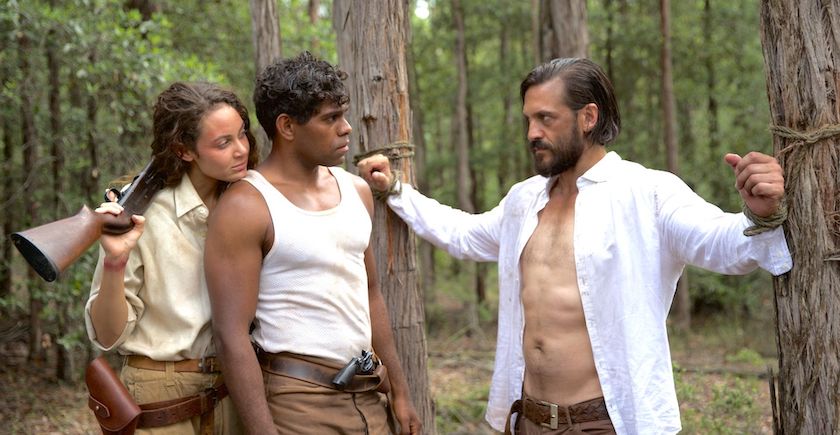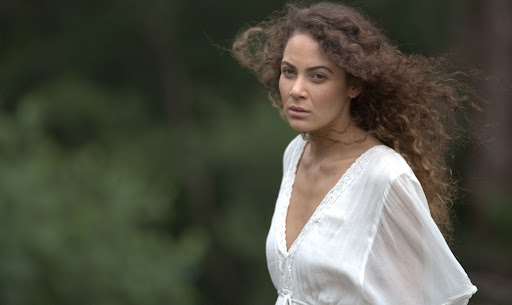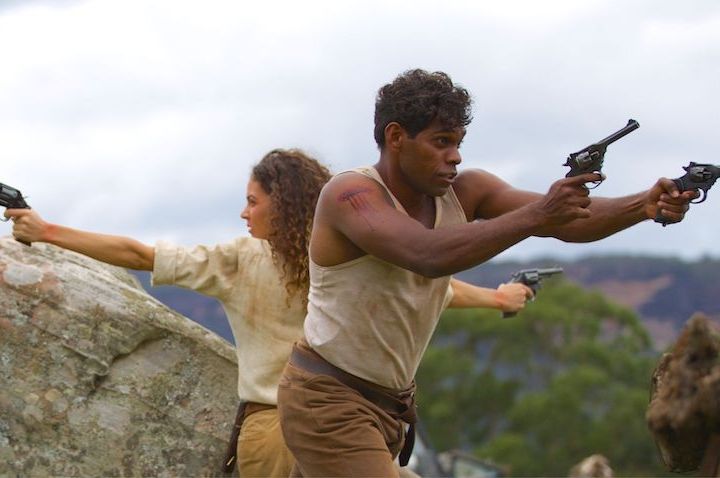
Go for a wild ride with Victoria Wharfe McIntyre’s ‘The Flood’
Who doesn’t love a good revenge western? The Flood is set in Australia during World War II and follows Jarah as she comes of age fighting against the country’s corruption. The film is brought to life by writer & director Victoria Wharfe McIntyre, who’s previously worked on films like Miro and El destello de la luna. Full of retribution, action, and a hearty amount of twists & turns, The Flood has something for everyone.
The Flood stars Alexis Lane, Shaka Cook, and Dean Kyrwood. It is McIntyre’s first feature-length directorial outing, and it’s already been taking critics by a storm with its gritty action and unique representation of First Nation People. McIntyre designed the story to be a “muscular pushback” on the way in which First Nation People have, and have not, been presented in film in the past.
The film’s official trailer can be viewed on YouTube now. The Flood will be available in the US on Digital, VOD and DVD November 2nd. We were lucky enough to get some time with Victoria Wharfe McIntyre. We spoke about the upcoming film, representation in media, and where she’s planning to go next.

What movie first made you fall in love with film?
Hmmm….there are three movies that sucked me into the cinematic vortex: Fantasia when I was a very little kid – the 1940s Disney film with trippy abstractions set to classical music, then Grease when I was older – the vitality, verve and musical numbers and the one that cemented the deal…Star Wars…
I remember sitting in hessian sling seats in a far north Queensland cinema and being totally blown away – there had been nothing like it – suddenly any world could be created on screen and we could travel the universe – cinema has been an obsession ever since.
Thanks George…I think…lol
How did you get started as a filmmaker?
Through writing and performance – I used to write and direct plays in primary school and tour them to different classrooms – then it was high school musicals. When you’re young you look at movies and think being an actor is what movie making is about, because you don’t immediately see all the other components at work, so I went on to study drama and become an actor.
I loved it but was pretty hammy and fortunately discovered that being behind the camera and generating stories was my true love.
After writing shorts and features the natural progression for a control freak is directing.
What are you most interested in exploring from a filmmaking perspective?
The awkward moments, the dynamics at play within silence, juxtaposition – how extreme opposites exist together in the moment.
The Flood captures this visually when we see this exquisite natural world, paradise, and yet Shamus and his gang perpetrate such horrors amidst the beauty.
We all live in that duality; in the vastness of the universe we have this shining jewel planet Earth and yet every day we destroy more and more of this rare gift.
You’re a writer and a director. Is there a part of the craft that you enjoy more than another?
I love being in the flow, being open and a channel for the script to pour onto the page, it is thrilling and joyful. I love writing myself into a corner and having no idea how it will resolve and then the moment when it reveals itself. I love actors. They are so brave and courageous, working with them in the crucible of the set, under so much pressure yet holding a space of freedom and time brings forth magic on screen. The energy and connection between cast and crew in those moments is divine.
I’ve worked with DOP Kevin Scott and composer Petra Salsjö on almost everything, we are the three pillars, words, music, pictures – combining those elements brings the greatest satisfaction – especially when it happens on set.
Petra will often write music from the script and we can play it on set or for the actors/crew before a scene and that feeling/tone/spirit inhabits the work. So often I find myself thumping Kev’s arm on set as we watch an incredible frame emerge or crying with Petra in her studio when we experience the music and pictures together.

Does knowing that you’ll direct a piece change your writing process?
I approach every script as if there are no restrictions of any kind, just let it flow and be what it is…then the practicalities come into the rewrites, adapting what is there to what we can achieve with the constraints of budget, time, etc.
Never seem to make it easy for my producing partner Armi Marquez-Perez, forever grateful that he will put himself through the wringer to squeeze everything we can onto the screen.
Your current project, The Flood, is your first feature film. Would you tell us where the film’s concept came from?
Like America, Australia was invaded by Britain and though the First Nation People on both continents fought to keep their home, defeat was wrought by the sheer numbers of the ‘modern’ military and armed colonists.
However, unlike America, Australia was deemed Terra Nullius, nobody’s land, empty and devoid of human life. This lie was perpetrated by people who saw Australia as an opportunity to become like the landed gentry they lived under in Britain and this blatant subterfuge has influenced our recorded history ever since.
Australian First Nation People have had every attempt made by the colonist invaders to wipe out their language, culture, lore, history and experience and this has left a dark legacy in our country.
Perhaps what I admire most about the Australian First Nation People I know, is their willingness to extend the hand of friendship and move forward united but to do this we must first face the truth of our past, the truth of our history and we must do this together.
We made The Flood with many First Nation Elders and People of Colour, it is a collective effort to look at our history, see the darkness and feel the sorrow of that together, only then can we let it move through us and be free to build a love and compassion based future together.
How does dealing with such a dark story affect the atmosphere on set?
The Flood has moments of magic and splendour, humour, deep profound love and nature spirit but it also shares some scenes of abject horror.
Films have a life of their own and this film came together in a very unusual way, it charged into the world and attracted people and repelled others. Ultimately, we found ourselves with a cast and crew passionate about telling this story and though it is often said you become a family when making a film, in this case we took it about as far as you can go without making it legal.
Looking back it is the strength of our connection and bond and the trust we had between us all that enabled us to dig down into the darkness together and capture it real and raw on screen.
The massacre scene was a very dark couple of days. When our First Nation actors and those playing the Mackay gang were facing each other in that canyon of pristine rainforest beauty, it was as though a switch was flicked and were back in time playing out the great shame of our nation. It was palpable and it is almost unbearable to witness, imagine what it must have been like to really experience it, we have to walk in those shoes to understand race relations and that is why it was so important to take the gloves off and get real in that scene.
That rainforest canyon, along with most of the film’s locations, was destroyed by the megafire not long after the shoot and one of our Elders said that we had released the trauma of the land and the fire was the land cleansing to be born anew.
We felt like we healed something in that darkness.
What do you think the movie business gets most wrong in its depiction of First Nation People?
I will leave that question for First Nation People to answer as it will be different for everyone but I can speak to my own thoughts around representation of Indigenous People in Australia, which is why I made Miro (available on Omeleto) which was also an inspiration for The Flood.
As mentioned earlier, it has been embedded in the Australian psyche to dismiss First Nation People from the moment the ships arrived in Botany Bay and particularly to deny the resistance and frontier wars fought by those nations all across the land.
I was not seeing the warrior spirit, the wisdom, the beauty, the majesty, the power of First Nation People on our screens, it has been an unconscious bias and Miro and The Flood are works that embrace those qualities.
The way you get it right is by collaborating and creating with First Nation People, by working together. We had Elders on set every day and I was constantly checking in with them and always deferring to their advice and wishes and we have made a film together that they love. The representations will not please all First Nation People but all we can do is make sure the people we are working with are happy with what we create and that is enough for me.
Do you see that approach beginning to change in any significant way?
We’re seeing vast improvements with First Nation voices finding pathways into film creation. I would like to think very few people now would make a film involving other cultures without working directly with people from that culture. Although First Nation and People of Colour would no doubt feel it a very slow evolution.

What was your biggest challenge while developing The Flood?
That’s a tough question, there is a very long list of huge challenges, it is difficult to identify one. It was all of them, a giant conglomeration across two years of life!
We had children, animals, remote locations, period era, giant cast and crew, 200 gun shots across multiple shoot outs (all done in post) flooding rains, fog and so much more and a very small and tight budget which meant we only had 5 weeks to shoot.
I’m also a producer on the film so have been across that side of things too, so probably my biggest challenge was managing all those elements and logistics whilst maintaining the heart, soul and eye of an artist and capturing that in those fleeting moments we get to turn the camera on.
What do you want your audience to take away from the film?
That no matter what we have done we can find redemption if we are willing to own the truth of our history and choices and feel what we need to feel in order to be free.
To witness and share another’s experience and therefore understand who they are and why they behave as they do and through that understanding find forgiveness which is the baseline for redemption and reconciliation.
Finally, I hope people let the beauty of the film live within, the music, the imagery, it can still bring me to tears after a thousand viewings…the waterhole scene, Jarah and Waru on the cliff and the special bonus right at the very end of the credits…it is wonderful to love your film.
Who are some of your current filmmaking influences?
Jane Campion, can’t wait to see The Power of the Dog, Quinten Tarantino pretty sure you can see his influence in some of the scenes in both Miro and The Flood along with David Lynch, there are certainly elements of his other worldliness in there. Also love the rawness and lyricism of Claire Denis.
My favourite hater so far described me as “a poor man’s Tarantino, a wanna be Wes Andersen trying to make a film to impress Peter Weir” and I’m very happy with that!
Are there any indie filmmakers working right now that we should be paying more attention to?
I’m really looking forward to seeing more from Emerald Fennell, Jennifer Kent and Shannon Murphy.
What’s your mission as a filmmaker? What do you want to communicate to your audience through all the work that you do?
My mission as a human is to raise my own consciousness and engage in compassionate communication and richer relationships, to heal and transcend emotional pain and connect more deeply and lovingly with the Earth and people. To experience peace, gratitude, harmony, contentment and satisfaction with the small joys of life.
If we all did that we would find waring, greed, destruction and probably even catastrophic climate change would be averted.
They say you teach what you need to learn so my films thus far and the ones in the future are built on that framework. Storytelling is how we can explore ourselves and what we create in the world and I would love for us all to live on a thriving, abundant, healthy planet, but we don’t get to do that without looking at everything that stands in the way of achieving it…guess that’s where our films come in…

Do you have any advice for someone who wants to write and direct their own feature film?
Everything that comes to mind sounds so clichéd. You have to believe, never give up, what you focus on expands, so stay focused and keep going and the stars will align. Personally I’ve found if you want to tell a meaningful story that inspires us towards greater understanding, better lives and futures, then people will want to help you do it.
There are a million different distractions today. How do you stay focused and motivated to keep creating?
If I had to keep myself motivated I wouldn’t bother doing it – it’s a compulsion, life would be so much easier if I didn’t love making movies so much and all the films and shows I spend much of life watching…that’s research right?
Outside of filmmaking, what are some of your greatest passions?
The natural world is my greatest delight, the trees, rivers, flowers, animals, oceans, mountains, the peace and contentment that comes from being in nature is the greatest gift – and it’s free! We can all experience that joy, even if it’s watching a bee buzz around a flower pot.
I live with my husband and pups Diddi and Bobby D (brother and sister schnoodles) on the edge of National Park, and every day I get to watch the sun rise above escarpments and turn the fog hovering on the river into a ribbon of gold.
Can you tell us about anything we can expect to see from you in the future?
Well, I’m done with the hard stuff at least for a while, the next film is going to be big, bold and fun but it will still be meaningful, subversive, stylish and super cool.
(must point out that I am in no way cool but can hold the space for others to bring it!)



